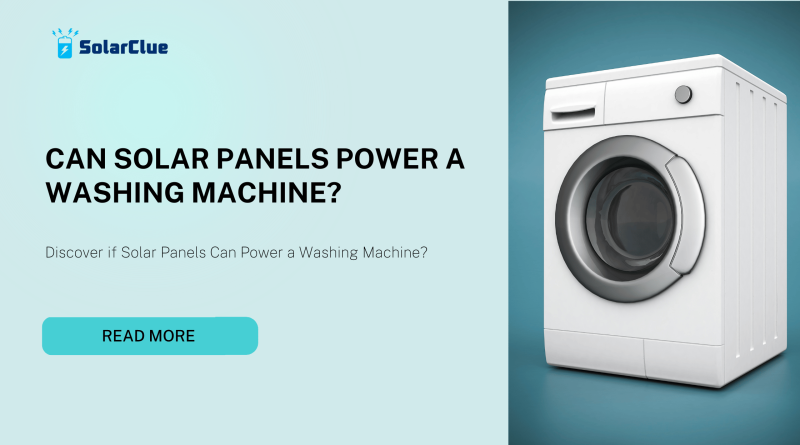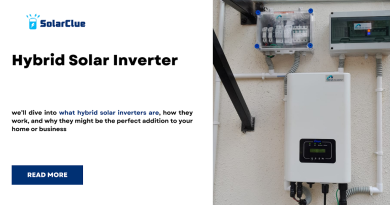Can Solar Panels Power a Washing Machine?
Powering a washing machine with solar energy is a sustainable and efficient way to reduce electricity costs and environmental impact. This blog explores the feasibility, requirements, and optimization strategies for running a washing machine on solar power.
Table of Contents
Energy Consumption of Washing Machines
The first step in powering a washing machine with solar energy is understanding its energy consumption. Washing machines typically consume between 400 to 1300 watts per cycle, depending on the model and settings. The average washing machine uses around 1 to 2 kWh (kilowatt-hours) per load.
To determine your washing machine’s energy consumption:
1. Check the manufacturer’s specifications for the wattage.
2. Estimate the number of loads per week.
3. Multiply the wattage by the duration of use to find the total kWh.
Example Calculation:
- A washing machine uses 1000 watts per cycle.
- Each cycle lasts for 1 hour.
- If you do 5 loads per week: 1000 watts x 1 hour x 5 loads = 5 kWh per week.
Sizing a Solar System for Washing Machine Power
To power a washing machine with solar energy, you’ll need to size your solar system appropriately. This involves calculating the required solar panel capacity, battery storage, and inverter capacity.
Solar Panel Size:
- Determine daily energy usage: 5 kWh per week / 7 days = ~0.7 kWh per day.
- Account for inefficiencies and sunlight variability (considering an average of 5 peak sun hours per day): 0.7 kWh / 5 hours = 0.14 kW or 140 watts.
- Add a safety margin (20-30%): 140 watts x 1.3 = 182 watts.
- Therefore, a minimum of 200-watt solar panel is recommended.
Battery Storage:
- Calculate the total energy storage needed: 0.7 kWh per day.
- Consider battery inefficiencies (typically around 20%): 0.7 kWh / 0.8 = 0.875 kWh.
- A 1 kWh battery storage capacity should be sufficient.
Inverter Capacity:
- Ensure the inverter can handle the washing machine’s peak load: 1000 watts.
- An inverter with at least 1200-watt capacity is recommended to handle surges and inefficiencies.
The Role of Battery Storage in Powering Appliances
Battery storage is crucial for ensuring a steady power supply, especially when sunlight is not available. Batteries store excess solar energy generated during the day for use during laundry cycles, typically conducted in the evening or at night.
Maximizing Solar Energy for Laundry
To optimize solar energy usage for laundry:
- Time Your Laundry: Run the washing machine during peak sunlight hours when solar energy production is at its highest.
- Energy-Efficient Appliances: Use energy-efficient washing machines to reduce overall consumption.
- Load Management: Wash full loads to maximize the energy efficiency per cycle.
- Low-Temperature Washes: Opt for cold or warm water settings to reduce energy used for heating water.
Sizing a Solar System for a Washing Machine
| Component | Calculation Method | Recommended Size |
|---|---|---|
| Solar Panels | Daily kWh / Sunlight hours x Safety Margin | 200 watts |
| Battery Storage | Daily kWh / Battery Efficiency | 1 kWh |
| Inverter | Washing machine wattage x Safety Margin | 1200 watts |
Cost-Benefit Analysis of Solar-Powered Laundry
Initial Costs:
- Solar panels: ₹20,000 to ₹30,000 (for 200-watt panel).
- Battery storage: ₹10,000 to ₹20,000 (for 1 kWh battery).
- Inverter: ₹5,000 to ₹10,000 (for 1200-watt inverter).
Savings:
- Reduced electricity bills.
- Return on investment within 5-7 years, depending on usage and local energy costs.
Environmental Impact:
- Reduced carbon footprint.
- Contribution to renewable energy adoption.
Potential Challenges and Solutions
Challenge: Insufficient sunlight during rainy seasons.
Solution: Increase battery storage capacity or use a hybrid system with a backup generator.
Challenge: High initial investment.
Solution: Look for government incentives, rebates, and financing options for solar installations.
The Future of Solar-Powered Appliances
The future holds promising advancements in solar technology and energy-efficient appliances. Innovations like smart appliances with optimized energy use and integrated solar systems will make solar-powered laundry more accessible and efficient.
Environmental Benefits of Solar-Powered Laundry
Using solar energy for laundry significantly reduces greenhouse gas emissions and reliance on fossil fuels. It promotes sustainable living and contributes to a cleaner environment.
Conclusion
Here at SolarClue®, we offer a smart, practical, and “beautiful” solution. You will be answered for all the questions related to Solar.
We provide all kinds of brands that are the Best Solar panels in India.
If you are the one who is planning for the solar power system. Don’t hesitate to contact our team!
Looking forward to empowering you with solar energy, just like hundreds of our other clients!
FAQs
1. Can I run a washing machine directly from solar panels without a battery?
It is possible, but not recommended, as solar energy production fluctuates. Battery storage ensures a consistent power supply, especially during cloudy days or at night.
2. How many solar panels do I need to power a washing machine?
Typically, one 200-watt solar panel is sufficient for powering an average washing machine, depending on its energy consumption and usage frequency.
3. What type of inverter is suitable for a washing machine?
An inverter with at least 1200-watt capacity is recommended to handle the washing machine’s peak load and ensure smooth operation.
4. Are there specific washing machines designed for solar power?
While standard washing machines can be powered by solar energy, energy-efficient models with lower wattage are more suitable for solar power systems.
5. How can I maximize the efficiency of my solar-powered washing machine?
Run the washing machine during peak sunlight hours, use energy-efficient settings, wash full loads, and maintain your solar power system regularly.



